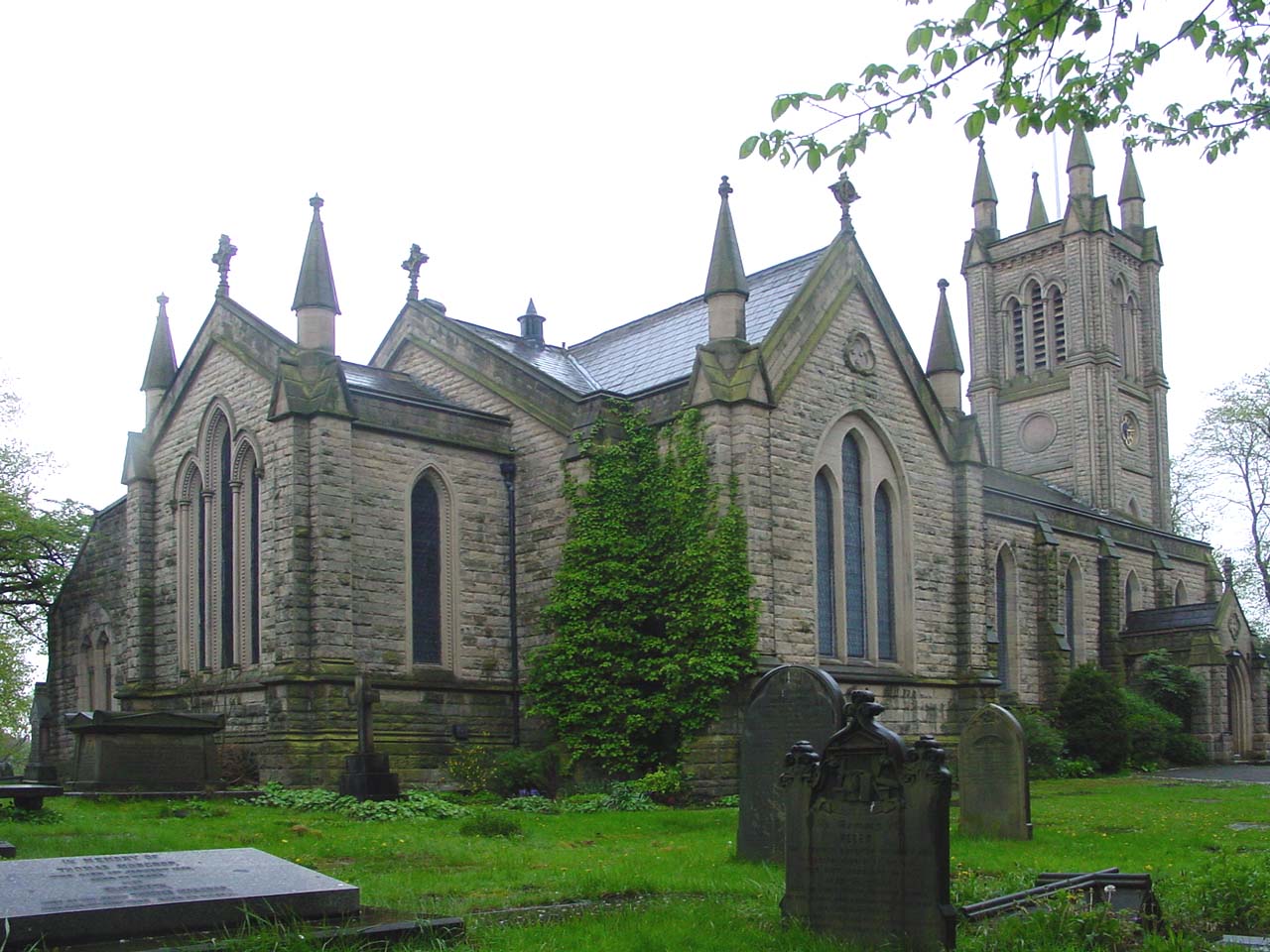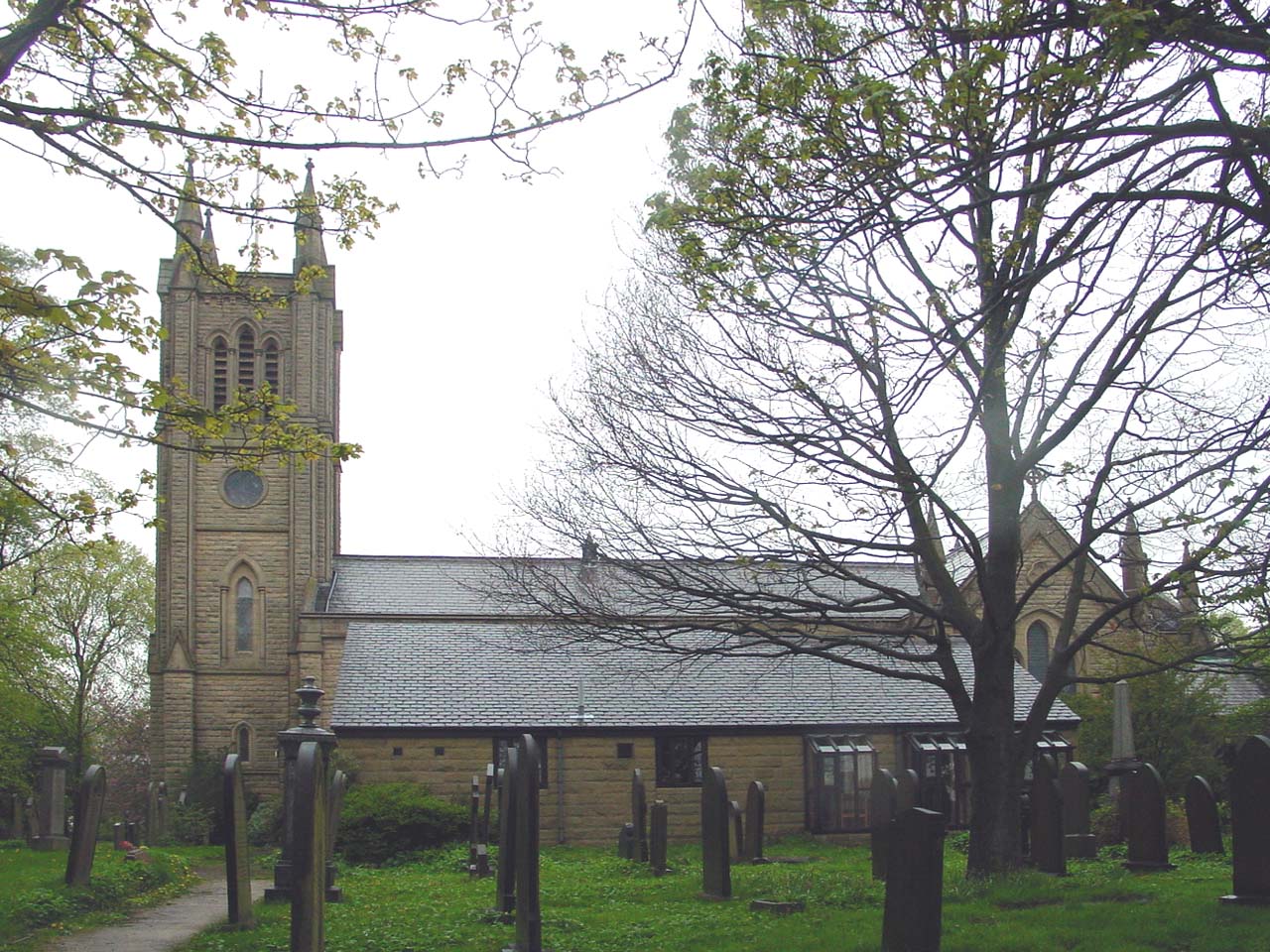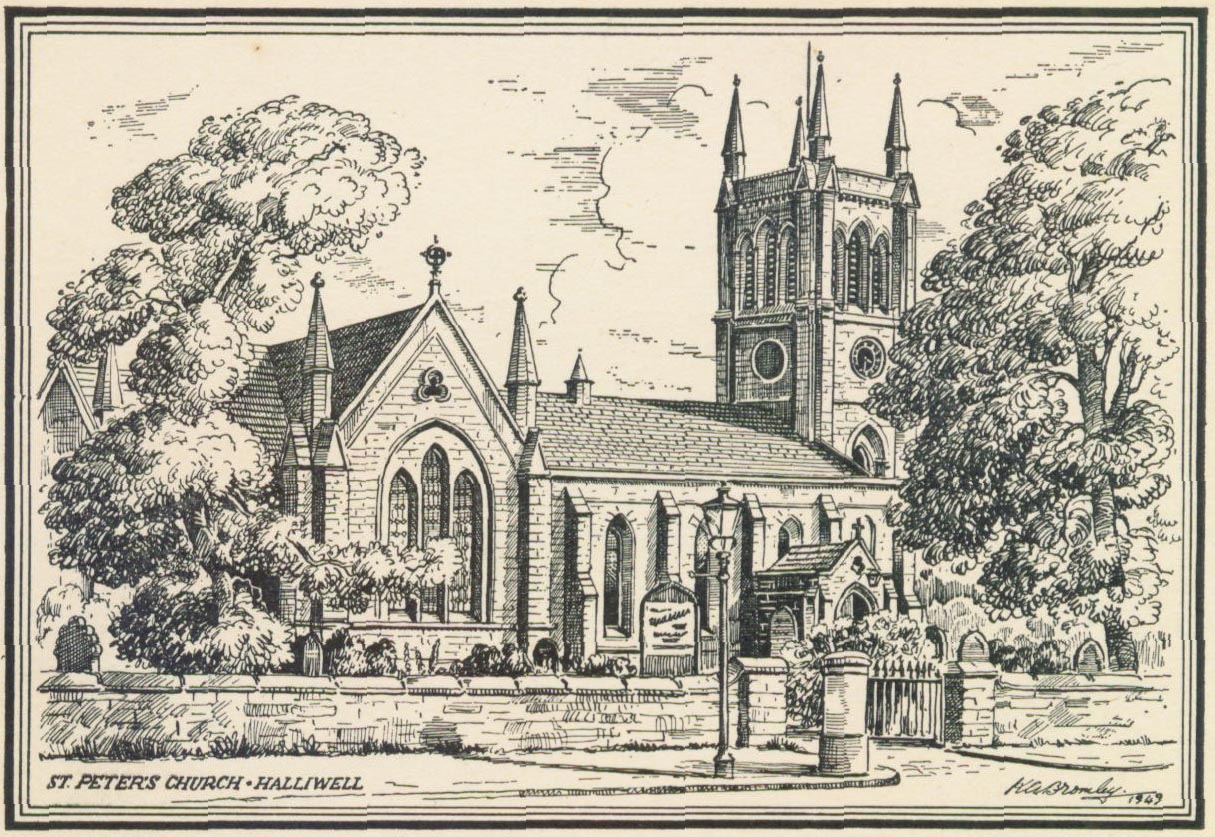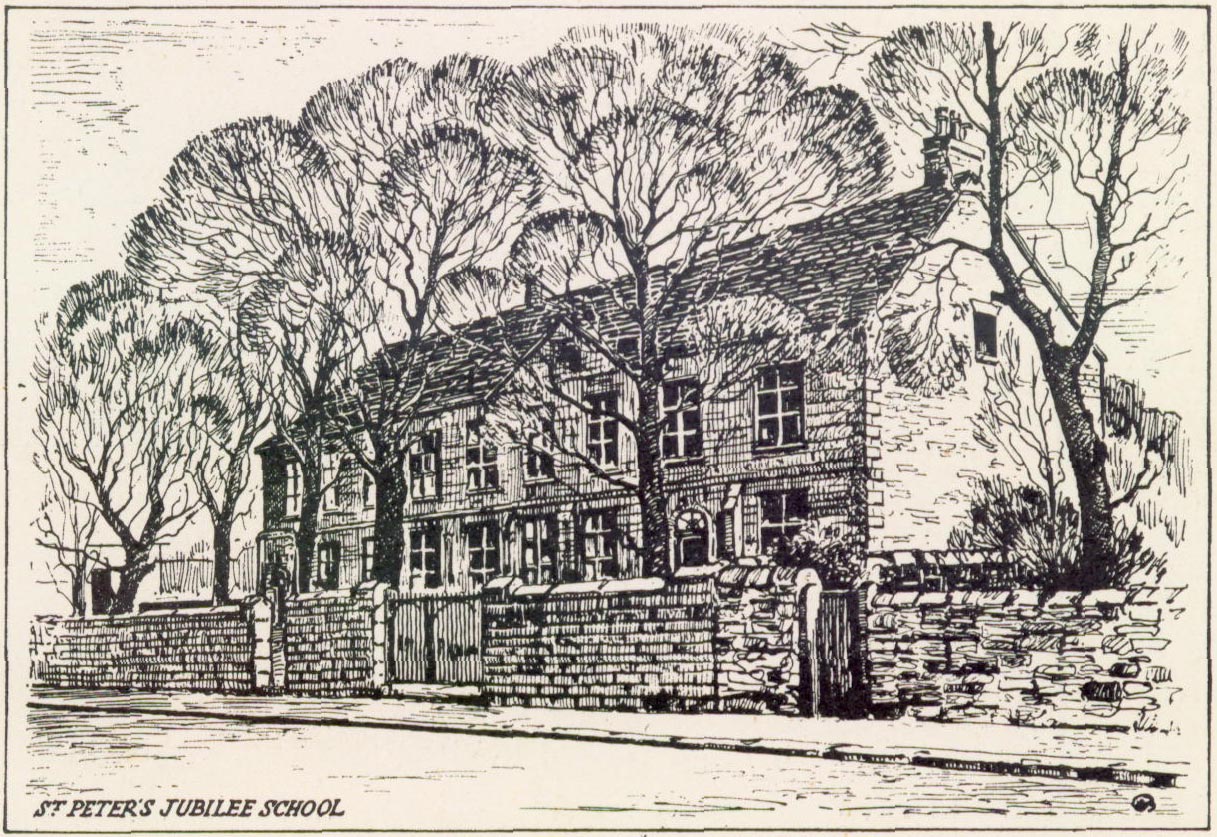 |
The
Parish of St Peter's, Halliwell |
 |
ST. PETER'S CHURCH, HALLIWELL, BOLTON
|
From The Bolton Journal and Guardian, Friday, December 18 1936, reproduced here by the kind permission of the Bolton News.
Whenever on a Sunday morning, write a "Journal and Guardian" representative, I hear the sound of St. Peter's bells borne in the breeze across the fields, I always think of the long walk which the Vicar, the Rev. P. Marr Davies, M.A., has to his church from his home. For he lives in Smithills Dean Rd., that having been his home since he was appointed chaplain of Smithills. On succeeding the late Rev. Percy Stott, B.D., as Vicar of St. Peter's, six years ago, Mr. Davies became honourary chaplain of Smithills, and thus there is a strong link between ST. Peter's, Halliwell, and what is one of the oldest known places of worship locally - the domestic chapel attached to Smithills Hall. There is another link. The Ainsworth family, for a considerable period the owners of Smithills Hall, and its extensive estate, which includes wide stretches of Smithills Moors, have been great benefactors. In fact the church was built at the whole expense of Mr. John Horrocks Ainsworth, of Moss bank, whose brother, Mr Peter Ainsworth, of Smithills Hall, was one of the M.P.s for Bolton from 1835 to 1847, and whose son, Col. R. H. Ainsworth, of Smithills Hall, died ten years ago. The church of St. Peter's was consecrated in October 1840, by the Bishop of Chester, the first Vicar being the Rev. W. C. Gibbs, M.A.. The architect was Mr. James Whittaker, of Ripple Dell, who lies buried in the churchyard under the shadow of the handsome church he designed. Its style is early English and cruciform in plan, with nave, transept and chancel. At the west end stands the imposing tower which contains a fine peal of bells. The coat of arms of the Ainsworth family are noticeable features of the interior. The church had been built only two years when signs of dry rot appeared in the timber, and it was decided to renew the whole of the interior of the fabric. A new roof was also provided and the church tower was considerably enlarged. A new organ and a peal of eight bells were put in at the time of the restoration, the cost of the whole being met by Mr. J. H. Ainsworth, who had founded the church, and whose remains rest in the family vault in the churchyard. In 1880, a further restoration of the church was carried out, a new vestry being erected at the time. The chief contributors to the repair fund on this occasion were Messrs. R. H. Ainsworth, J.P. (son of Mr. J. H. Ainsworth), W Hargreaves, J.P., J Ormrod, J.P., J. Cross Ormrod, J.P., T. H. Rushton, J.P., J. Heaton, and the Marquess of Rothwell. In 1933, a new vestry, in memory of the Rev. Percy Stott, who occupied the living for many years, was built on the south side of the church, adjoining the existing vestry and south transept. It is in the early English style of architecture to harmonize with the rest of the building. The new vestry was dedicated by the Bishop of Manchester, Dr. Warman. In interior of St. Peter's is devoid of ornament, the Communion table being without frontal flowers or cross. This is in keeping with what has always been the teaching and practice of St. Peter's, built up by Mr. Stott. St. Peter's is one of the centres of Evangelical churchmanship locally, and is one of the few churches where clergy exchange the surplice for a black gown before entering the pulpit to preach. True to its teachings, St. Peter's is a great missionary parish, raising hundreds of pounds annually for overseas missions, the amount raised ranking St. Peter's as one of the foremost parishes in the diocese in its missionary zeal and generosity. During recent years the population of Smithills parish has notably increased and St. Peter's now has a large community to serve, with the result that the congregations are invariably large. The Vicar has the assistance of the Rev. W. Russell Davey as curate, and a devoted band of lay-workers. |
 | |
|
Written in the 1950s by the then Vicar and reproduced here with permission. by the Vicar, the REV. R. E. Higginson, MA., B.D. The visitor to Bolton is at once arrested by the peculiar names on the Corporation Transport, e.g. Doffcocker, Montserrat, Smithills, Barrow Bridge, and Halliwell. All of them are districts in the Parish of St. Peter, Halliwell. “Doffcocker” in Victorian days was a small community served by the Church. Its name is derived from the incident of the Scottish packman who refused to pay toll at the bridge and preferred instead “to doff his cockers” (take off his socks and shoes) and ford the stream. "Montserrat" (serrated mountain) is a hilly part of the Parish beyond Doffcocker on the road North. The once verdant hillsides are now covered with Council Houses and served by St. Andrew's Mission Church in charge of a Grantee Lady Worker. “Smithills” is the “lung of Bolton” and in the town's “green belt”. It is famous for its Elizabethan Hall and “the footprint” of the Reformation Martyr, George Marsh. The Chapel once served that part of the Parish, but it is now closed. Extensions to the work are planned on that side of the Parish. At the present the Mill Canteen of the Bleach Works houses our Sunday School and a neighbouring Mill Canteen provides accommodation for the Croft Campaigners. “Barrow Bridge” is a local beauty spot frequented by Boltonians on Good Friday, when it is possible to walk on people's heads, so dense is the crowd! Disraeli visited this Model Village in 1851, and in his novel, Coningsby, portrayed it as “Millbank”. A small Mission Hall serves the village. “Halliwell” is a corruption of Holy Well, and covers a large area. Four Parishes have been carved out of St. Peter's in days gone by and now minister to the folk of Halliwell. Yet the Mother Parish is still an extensive one and embraces poor working class houses to farmsteads, and delightful suburban villas as well as Corporation dwellings. From the Vicarage windows a wide vista of moorland meets the eye. The most recent addition to the landscape is the I.T.V. mast (as tall as Blackpool Tower) near to “Scotsman's stump” on Rivington Moor. The needs of this attractive area are served then by the Parish Church' and its jubilee Sunday School, St. Andrew's and Valletts Mission Churches, Barrow Bridge Mission Hall, Smithills Dean and Croft Sunday Schools. The visitor to the Church is at once arrested by two distinguished names of former Vicars. The respective plaques commemorate the long and fruitful ministries of the Reverends Percy Stott and Percy Marr Davies. Mr. Stott made the Evangelical tradition of the Church distinctive by emphasizing direct giving and missionary endeavour. Mr. Marr Davies devoted his energies to administration and the provision of men for the Sacred Ministry. The former gave thirty years of his life to the work and died at a comparatively early age through the strenuous nature of his labours. The latter served as Chaplain to Smithills Hall under Colonel Richard Ainsworth and Mr. Nigel Ainsworth and succeeded Mr. Stott as Vicar. He also died here after seventeen years' toil. Both men are still revered in the Parish. For over a hundred years St. Peter's was a Village Church. In the last quarter of this century the scene has changed out of all recognition. Yet the Parish is even yet an attractive suburb of this large and vigorous industrial town, renowned for its civic pride, its cotton spinning, and its football team. In many ways it is an ideal place for a curacy, and a suitable house was procured some years ago to provide for this pressing need. Through the generosity of the Church Pastoral-Aid Society an Assistant Curate and Lady Worker help the Vicar to meet the many demands upon time, energy, and patience, in an extensive work of this kind. Much could not be done apart from the invaluable help supplied by capable laymen and women. Other clergy talk about lay leadership. We have it! All the six Sunday Schools are manned by voluntary workers and many of the Mission Services are staffed by them. Within the last seven years four young people have gone forth as missionaries to India; one young woman recently sailed for Malaya; one young man is training at the London Bible College and hopes to enter the Ministry; one young woman taking a Teaching Diploma in Scripture at St. Michael's House, Oxford; another young man hopes to enter Tyndale Hail, Bristol, in September; while another young man is shortly to he licensed as a Parochial Lay Reader. The present policy is to encourage the Mission Halls to develop into Mission Churches and ultimately attain separate status. In the pulpit stress is laid upon a “full orbed” ministry. Teaching has a central place in the curriculum. Series of sermons are regularly given. At the weekly Bible School-cum-Prayer Meeting progressive study of the Word of God is followed. Every three years an Evangelistic Mission is held and in the Autumn of 1956 the Reverend Richard Rees is due to hold a ten-days' Campaign. We are beginning our preparation for this drive on the Parish. In former days Bolton was known as “the Geneva of the North”. Now we are the only Church left in the town to retain the use of the preaching gown and bands. This custom stamps the Church as Protestant to the core. Yet the dead hand of the past is not upon us! Through the agency of the Young Wives' League over a hundred ladies are brought under the viund of the Gospel each Wednesday. The Missionary Working Pam is another group of Ladies, meeting on the same night, who make garments for the parcels sent out each Christmas to our eleven missionaries in Burma, Africa, India, and Malaya. At the Annual Toy Service the children are taught missionary giving and their gifts of small toys make one of the titbits in the parcels each year. The Campaigners and Pathfinders (our own brand) serve the youth. One feature of recent Confirmations has been the preponderance of adults, who prove to be regular communicants. The Missions have their own independent life and activities too numerous to relate here. Slowly but surely the congregations and collections have grown over the past eight years. More ought to be done and could be done with a larger staff. Our problems are not a few, but with a co-operative P.C.C. it is possible to face them with confidence. The fellowship in the Gospel is warm, and the intelligence of the people assists in the proclamation of the Gospel. Behind all activity is the consuming desire to win souls for Christ, and to build up the Church in "the Faith once for all delivered to the saints”. Worship is conducted in a reverent, simple, and fervent manner, in a Church which is conducive to spiritual life. On the first Sunday of the present Incumbent's ministry the Old Testament Lesson had for its keynote the words "thou mayest add thereto". For nearly nine years the aim has been to advance Christ's Kingdom by building on the foundations laid down by honoured predecessors. Whatever success has attended that endeavour is to be ascribed to the glory of God. |
 | |
 | |
 | |
| Bolton Home & Contents | ©Lancashire OnLine Parish Clerks | Lancashire Home |